Growing Summer Squash Vertically
This post may contain affiliate links, which means that I may receive a commission if you make a purchase using these links. As an Amazon Associate I earn from qualifying purchases.
Summer squash are among the easiest and most productive plants to grow in the garden. They are fun to grow too since there are so many different shapes, colors, and varieties. Often times I find myself trying to squeeze in more varieties than I have room for in the garden.
Summer squash loves the summer heat, and usually begins producing within 60 days after planting and continues all season until frost, disease, or squash vine borer takes it out.
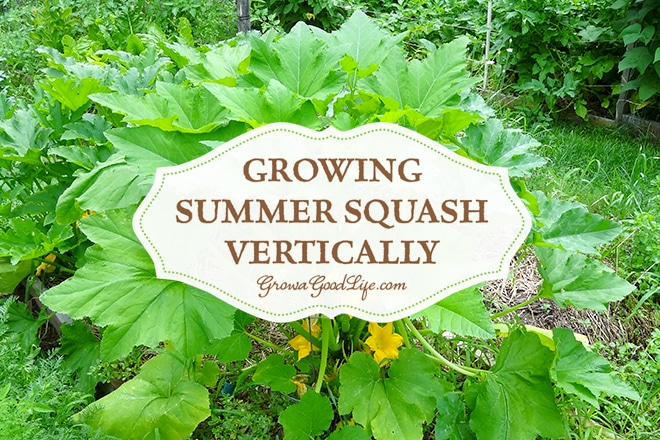
What is Summer Squash?
Squash is divided into two types, winter squash and summer squash. Summer squash differs from winter squash in that it is harvested young while it is still tender.
There are so many varieties of summer squash, including zucchini or courgette, patty pan or scallop, yellow crookneck, and yellow straight neck squash. Each type has many varieties, colors and shapes.
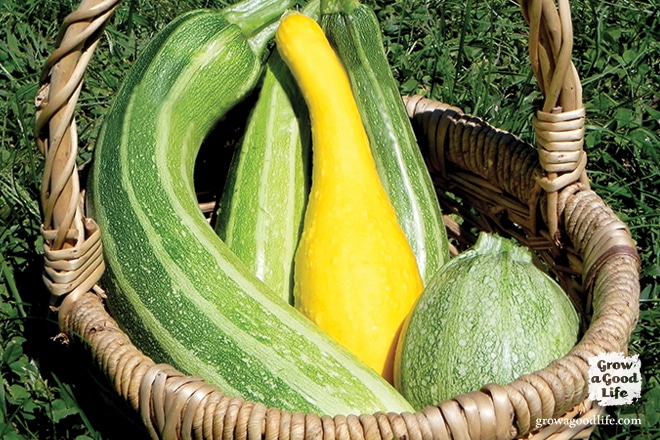
In contrast, winter squash has a thicker rind and is harvested in the fall, cured, stored, and consumed during the winter months. Common winter squash varieties include acorn, butternut, pumpkin, and spaghetti squash. Winter squash usually grows on long, rambling vines.
Most summer squash have a bushy growth habit. The fruit begins forming at the base of the stem and continues developing up the stalk as the plant grows. Even though summer squash plants are bush like, the stem of the plant does tend to lengthen a little as it grows.
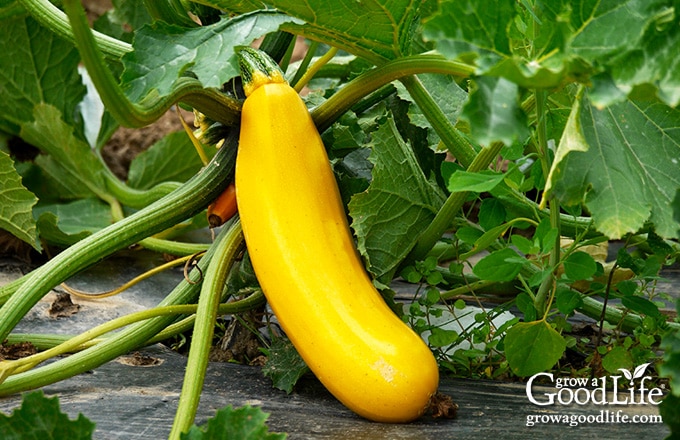
Since I have been converting my garden to permanent raised beds that are only 3-feet wide, I had to think of some creative ways to keep the summer squash confined to the bed and prevent it from flopping out into the aisles. For me, the logical answer was to grow summer squash vertically using tomato cages to support the plant and keep it upright.
Benefits of Growing Summer Squash and Zucchini Vertically
Although the reason I wanted to grow summer squash upright was to save space, I quickly discovered that growing summer squash and zucchini in tomato cages had other benefits as well.
- Growing summer squash vertically saves space. The plants can easily be trained to remain in the tomato cage as it grows. The cage provides support and keeps the plant upright, preventing it from flopping out of the growing bed into the walking paths.
- Growing zucchini upright encourages air movement. Good air circulation around the plant helps the foliage stay dry and averts downy mildew and other fungal diseases.
- Vertical growth keeps the squash off the ground. There is less chance of the fruit rotting from excess moisture since the squash is not touching the ground.
- It’s easier to see the zucchini to harvest. Growing upright allows the squash to be more visible reducing the chance of overgrowth. No more giant zucchinis!
- More light gets to the plant when growing upright. Zucchini and summer squash thrive in sun. Since the foliage is more spread out when growing upright, there is less shading allowing the plant to absorb more sunlight. Also, most pollinators prefer to forage in sun.
- Less places for squash bugs and other pests to hide. Squash bugs, cucumber beetles and other pests have less area to hide near the ground. Also, since the foliage is upright, it is easier to scout for and destroy eggs before they hatch.
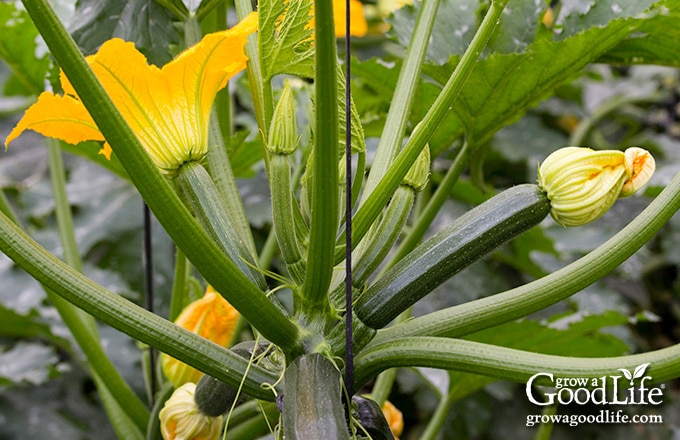
How to Grow Zucchini in Tomato Cage
Step 1: Plant the zucchini and summer squash. Either transplant seedlings or direct sow summer squash in a mound of soil.
Step 2: Add the tomato cage. Simply place a tomato cage securely in the ground when the zucchini and summer squash are young. Push the legs into the ground up to the first ring.
If you are using a flimsy tomato cage, hammer in a stake or long piece of rebar for extra support. Tie the tomato cage securely to the stake.
Step 3: Mulch the plants. Add organic mulch around the plants to help keep the weeds down, the roots cool, and conserve moisture. Keep the mulch a few inches away from the stem of the plant.
Step 4: Guide the zucchini and summer squash up. As the plant grows, gently direct the foliage and stem upward through the tomato cage. A few of the hollow stems do bend over the cage wires as the plant grows, but overall the benefits of growing summer squash vertically outweigh a few bent stems.

Growing summer squash vertically by trellising or in tomato cages helps to save space, encourages air circulation, and allows the squash to be more visible reducing the chance of overgrowth.
You May Also Like:
- 3 Easy Ways to Preserve Summer Squash
- Zucchini Garlic Bites Recipe
- DIY Self-Watering Containers
- How to Build a Square Food Garden
Good planning is key to a successful vegetable garden
Whether you are new to growing your own food or have been growing a vegetable garden for years, you will benefit from some planning each year. You will find everything you need to organize and plan your vegetable garden in my PDF eBook, Grow a Good Life Guide to Planning Your Vegetable Garden.
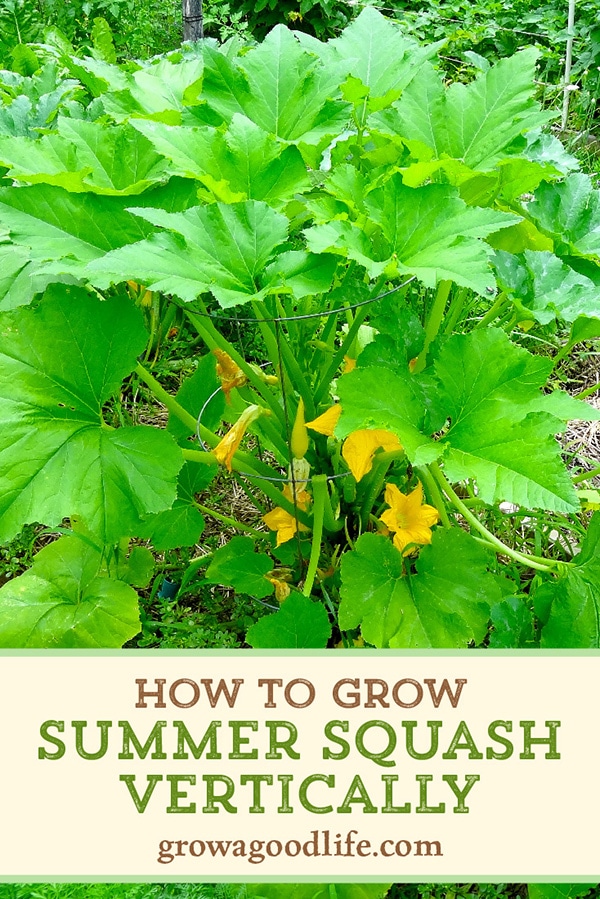


Thanks for the advice! I’m growing an acorn squash for the first time, and it is growing like crazy! It’s small enough still for me to put a tomato cage around it, so I will see how it does 🙂
Stacie, This method won’t work well for acorn squash. The vines will grow too long to keep them contained in a tomato cage. You can, however grow acorn squash on a larger trellis like the ones used for indeterminate tomatoes in this article: 9 Creative DIY Tomato Trellis Ideas.
I am trying vertical for first time and it is successful for both zucchini and cucumber. My problem is the zucchini is growing so tall and long that it has grown up and out of the garden – at least 6 feet long and growing! Is this a good thing or should I cut the length down? It’s out of control!
Kathy: Wow, that sounds like one healthy zucchini plant. Personally, I would let it ramble as long as the plant is healthy and producing fruit.
I am losing at least one squash or zucchini plant everyday due to thunderstorms. My plants are huge and are growing vertically without any cages. I’ve been mounding more dirt around them every few days to try to stop the wind damage. Do you have any recommendations before I lose all of them?
Cheryl, Windy storms can wreak so much havoc on a vegetable garden. The only advice I can give is to try to continue mounding the soil so the roots are not ripped out by the wind. It is probably too late now since you plants are large, but adding a tomato cage when the plant is young will help provide some support and shelter in windy weather.
Could you cage them after they’ve started to get blossoms/grow? Is it too late?
Yes, it is not too late as long as you can get the cage on without damaging the plant or roots.
Usually we plant 2-3 plants per mound. For the cages is it only one plant per cage?
Yes, one plant per cage. 2-3 plant would be too crowded.
Thank you for this helpful information.
I’m growing zucchini in a tomato cage and have some large very low leaves at the bottom that will break if I try to guide them through the cage at this point. Is it advisable to cut some of these lower leaves off to increase air circulation and to be able to see the zucchini?
Michele, Yes, go ahead and trim off some of the bottom leaves.
Has anyone tried growing them in a large pot? I could put it on my porch.
Bonnie, Yes, you can grow summer squash and zucchini in large containers. Look for varieties that stay compact like Black Magic, Gold Rush, or Eight Ball zucchini, and Bush Crookneck summer squash.
If you find a pot and a tomato cage (or tube of lage hole plastic coated mesh) with a similar diameter, you can use the upright method on the potted cougette too. If it’s a tube of mesh, you can place the whole pot inside the tube. As the mesh is also on the ground this makes the plant more stable.
How much space per plant with using a cage?
Amy, I would still give the plant plenty of room, probably 2-3 feet spacing.
Can this be done with cucumbers too? Looking to grow both summer squash and cucumbers. I have them started and will need to transplant soon. Trying to decide how to trellis all of them. This is a better idea than making a ‘wall or stand’ for them to trellis!
Amy, Yes, you can grow cucumbers in tomato cages if you choose bush cucumbers. Bush varieties grow shorter and more compact plants. Regular cucumber plants grow long vines that would quickly overgrow a tomato cage. Bush cucumber varieties to consider: Spacemaster, Salad Bush, and Pot Luck.
Hello! Thank you for this informative piece! What size tomato cages do you recommend? Thank you in advance!
Victoria, Use the very large tomato cages, at least 48-inches. The smaller ones just bend over with the weight of the plant.